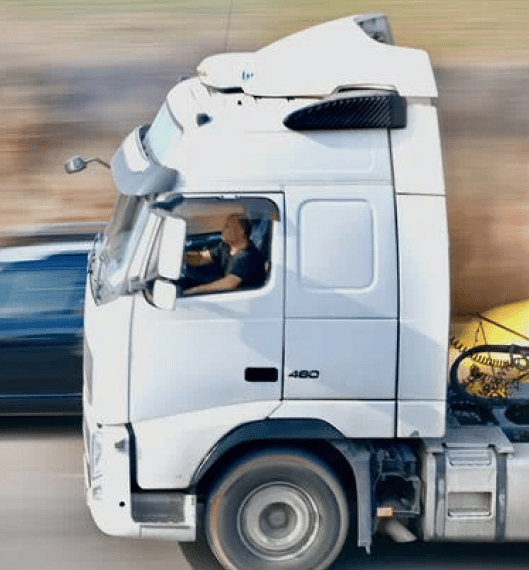Types of Truck Accidents
Home » Types of Truck Accidents
Truck crashes are on the rise. In 2020, 107,000 trucks were involved in crashes that resulted in injury, and 4,965 led to deaths. Commercial truck driving requires professional safety training.
The most common causes of truck accidents are driver distraction and inattention. Many trucking companies pressure workers to meet unreasonable delivery deadlines, forcing them to work excessively long hours, leading to driver fatigue. These pressures also induce drivers to drive at unsafe speeds and take shortcuts on federally mandated inspections.
The trucking industry jeopardizes public safety when they place these unreasonable demands on their workforce. They are liable for all the different types of truck accidents caused by their fatigued drivers.
Rear-End Truck Accidents
Rear-end collisions occur as a result of following too closely, speeding, distraction, inattentiveness, or brake failure. Passenger cars are unable to withstand the force of a large truck striking in the rear. The impact can push the car into another vehicle or crush it. Rear endings by large trucks are often deadly, as in the case of seven family members in Indiana who were killed after being rear-ended by a semi.
Tire Blowouts
Tire blowouts can cause any vehicle to lose control on the road, resulting in a severe accident. Commercial vehicles are heavy, especially when fully loaded, placing a significant amount of pressure on the tires. Vehicles that are illegally overloaded are the most susceptible. The following types of commercial motor vehicles regularly carry heavy loads:
- 18-wheelers
- Cement trucks
- Heavy haulers
- Tankers
- Flatbeds
In addition to heavy loads, improperly maintained tires can cause blowouts on any type of commercial vehicle.
Wide-Turn Accidents
Long 18-wheeler trucks require extra space to negotiate right turns. If they fail to turn widely enough, their rear wheels can clip the curb and cause the truck to roll over. While it is necessary for drivers to use a wide radius while making right turns, many use improper techniques that confuse other vehicles and cause crashes.
The most common errors truckers make while turning are as follows:
- Turn signal errors
- Failure to maintain the signal so it is in working condition and unobstructed
- Failure to use the signal
- Swinging out too far left and failing to keep the rear of the vehicle close enough to the curb—this confuses other drivers by creating the
appearance that the truck is switching lanes - Improper use of the mirrors that would allow the driver to see vehicles or pedestrians approaching the vehicle
- Lack of awareness of the truck’s blind spots
In addition to passenger vehicles, children, pedestrians, and bicyclists are also at risk in this type of accident.

Underride Accidents
Underride accidents occur when a car collides with the side or rear of a semi-truck trailer. These accidents are often the result of visibility challenges. The gray color of trucks blends with the road, making them difficult to discern, especially at night, during very bright sunny conditions, and in weather conditions that impact visibility.
Underride accidents are some of the most dangerous and deadly accidents that occur. The height of most big rigs is in line with the heads of the occupants of most passenger vehicles, creating a strong risk for fatal head and neck injuries.
Some studies have shown that equipping trucks with underride guards could be an effective measure to prevent underrides and save lives.
Jackknife Accidents
Jackknife accidents occur when a semi-truck driver loses control of the angle between the tractor and the trailer. The trailer swings out to a 90-degree angle, the wheels lock, and the truck skids. Jackknifing most commonly occurs as a result of the following:
- Sudden braking
- Decelerating around curves
- Swerving
Although these actions are not always avoidable, well-trained, experienced truck drivers can take measures during emergency situations to avoid jackknifing. Jackknifed trucks can roll over or hit other motorists.
Rollover Truck Accidents
Large commercial trucks have a high center of gravity, which affects steering and maneuverability. It also makes them vulnerable to rollover crashes. The most common contributing factors in rollover crashes are as follows:
- Unsafe speeds around curves and turns
- Windy weather
- Swerving to avoid an animal, vehicle, or another object
- Improper or sudden braking
- Over corrections
- Adverse road conditions
- Brake failures
Tractor-Trailers
Semitrucks are especially prone to rollovers in windy weather conditions. The risk is even higher when their trailers are empty. Slower speeds and windbreaker structures can mitigate these risks. Drivers should stay off the roads if sustained winds exceed 37 miles per hour.
Tractor-trailers are also vulnerable to rollover accidents when the cargo is improperly loaded. If not properly secured, the weight can shift. This could cause the truck to roll over when turning, driving around curves, or even braking.
Cement Mixers
Cement mixers carry large quantities of wet cement in tall, cylindrical-shaped structures. When these structures turn, they mix the cement. Cement is heavy. As a result, cement mixers are top-heavy. This significantly increases their rollover risk.
Due to the properties of cement, it must be unloaded within 90 minutes of loading. Unlike big rigs, cement mixers drive primarily in urban areas, increasing the likelihood of other vehicles being impacted in a rollover.
Tanker Trucks
Tankers carry hazardous liquid products such as gasoline, which can ignite in a crash, making crashes of any kind especially dangerous for the driver as well as for occupants of other involved vehicles.
Tankers are susceptible to rollover crashes when they carry a partial load. When liquid cargo has space to “slosh and surge,” the weight can easily shift every time the vehicle turns, stops, starts, or changes speed. This is a factor in 63 percent of tanker rollovers.
Garbage Trucks
Garbage trucks are common in urban areas, which places other vehicles, pedestrians, bicyclists, and even children playing at risk when they roll over.
Garbage trucks are susceptible to rollovers because of their constantly changing center of gravity. They begin the day empty, with most of their weight in the front. As they fill up, the weight shifts toward the back. Changes in the center of gravity alter the handling and steering.
Heavy Haulers
Vehicles that haul heavy equipment, prefabricated homes, and other oversized objects cannot navigate sharp curves and corners the same way other large vehicles can. They also must avoid sudden braking. Their loads can easily break apart or shift, causing drastic changes in weight distribution leading to rollovers.
T-Bone Accidents
When a truck drives into the side of another vehicle, it is termed a T-bone accident. These accidents most often occur at intersections after the truck has passed a stop sign or red light without stopping. The damage is typically more severe if the passenger side of the car is hit. Even at low speeds, the damage and level of injury after being T-boned by a truck are usually severe.
Sideswipe Collisions
These types of collisions most commonly occur during lane changes on city streets and highways, and while merging into traffic via on-ramps and off-ramps. Trucks have significant blind spots, and inexperienced or poorly trained drivers may not be aware of vehicles in their blind spots, which extend to the front, sides, and rear of large commercial trucks.
One common scenario is when a truck lightly hits the corner of a car while switching lanes, causing the car to spin out of control into the truck’s path. The truck then fully hits the car at a high speed, causing fatal or catastrophic injuries to the occupants.
Head-On Collisions
Head-on collisions are most common on rural roads, which are commonly straight two-lane roads. Truckers are often less vigilant when driving on rural highways, and they drive at higher speeds. They also may fall asleep at the wheel due to fatigue and the monotony of some rural areas.
Head-on collisions can occur if the truck veers into oncoming traffic, swerves, or otherwise becomes out of control. They also occur after passing or attempting to pass vehicles on two-lane roadways.
Head-on collisions are the second-most-deadly type of crash after T-bone crashes, and they are even worse when a large truck is involved. West Texas is a mostly rural area known for its flat roads and plain scenery. This is also the site of heavy truck traffic. This area is widely known throughout Texas for its high death toll on its highways.
Occupational Truck Accidents
Truck driving is the seventh-most-deadly profession. Truck drivers face daily risks from other drivers, mechanical failures, pressures from their companies, fatigue, and negligent maintenance by their companies.
The Federal Motor Carrier Safety Administration (FMCSA) limits the amount of time truck drivers can work, but the hours allowed are extensive. Many companies push their drivers to exceed these limits, increasing driver fatigue and the risk of accidents.

Lift Truck Accidents
The most common types of truck accidents involving lift trucks, also known as forklifts, are as follows:
- Rollovers
- Worker on foot struck by a forklift
- Victim crushed by a forklift
- Fall from a forklift
In many cases, workers near forklifts are crushed or struck. Approximately 100 workers are killed by forklifts every year, and 20,000 more are seriously injured. Negligent maintenance, inadequate training, and lack of safety guidelines contribute to these serious and potentially fatal injuries and deaths.

Mining Industry
Heavy mining trucks with huge blind spots drive within close proximity of their workers in smaller vehicles. This has caused dozens of commercial truck accidents, but the mining industry has largely failed to invest in relatively inexpensive safety equipment. The result is terrible accidents leading to employees dying of crushing injuries, as in the case of a 52-year-old miner in Arizona.

Flatbeds
Improperly loaded cargo on flatbed trucks can come loose during braking and turning activities. Large objects such as timber and industrial steel beams can break into the cab and impale the driver. Many companies fail to provide appropriate training and safety supplies.

Dump Trucks
Dump trucks are prone to rollovers, which can severely injure occupants of the truck as well as nearby workers. The highest risk of rollover occurs when the box is in the raised position during loading or unloading, especially when the following circumstances are present:
- The ground is uneven or sloped.
- The surface is soft.
- Materials are loaded unevenly, causing the truck to become
unstable. - The load does not flow during dumping.
- The truck receives inadequate maintenance or has a
mechanical failure. - The truck is exposed to high winds.
Employers and property owners could prevent many of these accidents by providing safe areas for loading and unloading.
Truck Crash Injuries
Trucks are 20 to 30 times heavier than cars. Their added size and weight result in more fatalities and serious injuries than car accidents. Any type of truck accident can cause the following severe injuries:
- Spinal cord injuries .
- Traumatic brain injuries
- Broken bones
- Organ damage
- Whiplash
- Soft tissue injuries
Truck Accident Lawyers at Lanier Law Firm
If you or your loved one has been injured in a trucking accident due to a negligent driver, employer, or trucking company, the truck accident attorneys at the Lanier Law Firm can help.
We have over 30 years of experience helping our clients stand up to large companies and insurance agencies so truck accident victims can receive their much-deserved compensation.
We handle truck accident cases nationwide from our personal injury law office locations in New York, Houston, and Los Angeles. Contact us today to schedule your free consultation.
By submitting this form, you agree to our terms & conditions. Please read full disclaimer here.



